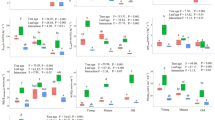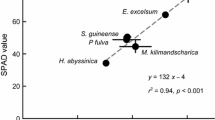Abstract
In many plant species, herbivory is a major determinant of leaf mortality and it can cause a strong reduction in productive potential. Most predation occurs on young, expanding leaves. Thus, a rapid growth of the leaves can reduce the impact of predation. Furthermore, in cold Mediterranean climates the length of the growing season is constrained to a short period in spring and early summer owing both to low winter temperatures and drought stress in early summer. Therefore, a rapid deployment of leaf area and a high photosynthetic capacity during the spring and early summer might have important positive effects on the final carbon balance of the leaf population. Relative growth rates (RGR) of leaf biomass were measured in 19 woody species typical of Central Western Spain with deciduous and evergreen habits. Highly significant differences were detected in the leaf growth rate of the different species. The differences between species, however, did not correlate either with the mean leaf life-span of each of the species or with other leaf traits such as photosynthetic capacity, specific leaf area or nitrogen content. Leaf growth rate was positively correlated with time elapsed between leaf initiation and fruit maturation, so that species with fruit dispersal in spring and early summer in general had lower leaf growth rates than species with autumn fruit shedding. This relationship shows the effects of the concurrence between vegetative and reproductive organs for nutrients and other resources. Nitrogen concentration in the leaves was very high at the time of bud break, and declined during leaf expansion owing to the dilution associated with the increase in structural components. The rate of nitrogen dilution was, thus, positively related to the leaf growth rate. Relative growth rates calculated for nitrogen mass in leaves were very low compared to the growth in total mass. This suggests that most leaf nitrogen is translocated from the plant stores to the leaf biomass before the start of leaf expansion and that the contribution of root uptake during leaf expansion is comparatively low.
Similar content being viewed by others
References
Aerts R. 1996. Nutrient resorption from senescing leaves of perennials: are there general patterns? J. Ecol. 84: 597–608.
Aide T.M. and Londoño E.C. 1989. The effects of rapid leaf expansion on the growth and survivorship of a lepidopteran herbivore. Oikos 55: 66–70.
Cannell M.G.R. and Smith R.I. 1983. Thermal time, chill days and prediction of budburst in Picea sitchensis. J. Appl. Ecol. 20: 951–963.
Catalán-Bachiller G. 1985. Semillas de árboles y arbustos Forestales. Icona, Madrid.
Cavender-Bares J. and Holbrook N.M. 2001. Hydraulic properties and freezing-induced cavitation in sympatric evergreen and deciduous oaks with contrasting habitats. Plant Cell Environ. 24: 1242–1256.
Chapin F.S. III, Autumn K. and Pugnaire F. 1993. Evolution of suites of traits in response to environmental stress. Am. Nat. 142: 78–92.
Clark D.B. and Clark D.A. 1988. Leaf production and the cost of reproduction in the neotropical rain forest cycad, Zamia skinneri. J. Ecol. 76: 1153–1163.
Cornelissen J.H.C., Castro-Diez P. and Hunt R. 1996. Seedling growth, allocation and leaf attributes in a wide range of woody plant species and types. J. Ecol. 84: 755–765.
Cornelissen J.H.C., Werger M.J.A., Castro-Diez P. and Rheenen A.P. 1997. Foliar nutrients in relation to growth, allocation and leaf traits in seedlings of a wide range of woody plant species and types. Oecologia 111: 460–469.
Damesin C. and Rambal S. 1995. Field study of leaf photosynthetic performance by a Mediterranean deciduous oak tree (Quercus pubescens) during a severe summer drought. New Phytol. 131: 159–167.
Dougherty P.M., Teskey R.O., Phelps J.E. and Hinckley T.M. 1979.Net photosynthesis and early growth trends of a dominant white oak (Quercus alba L.). Plant Physiol. 64: 930–935.
Duhme F. and Hinckley T.M. 1992. Daily and seasonal variation in water relations of macchia shrubs and trees in France (Montpellier) and Turkey (Antalya). Vegetatio 99: 185–198.
Escudero A. and Del Arco J.M. 1987. Ecological significance of the phenology of leaf abscission. Oikos 49: 11–14.
Fenner M. 1998. Phenology of growth and reproduction in plants. Perspectives in Plant Ecology, Evolution and Systematics. 1: 78–91.
Field C., Merino J. and Mooney H.A. 1983. Compromises between water use efficiency and nitrogen use efficiency in five species of California evergreens. Oecologia 60: 384–389.
Gratani L. 1996. Leaf and shoot growth dynamics of Quercus ilex L. Acta Oecol. 17: 17–27.
Havaux M., Ernez M. and Lannoye R. 1988. Tolerance of poplar (Populus sp.) to environmental stresses. I. Comparative study of poplar clones using the in vivo chlorophyll fluorescence method. Acta Oecol. 9: 161–172.
Ho L.C. 1992. Fruit growth and sink strength. In: Marshall C. and Grace J. (eds), Fruit and Seed Production. Aspects of Development, Environmental Physiology and Ecology. Cambridge University Press, New York, pp. 101–124.
López-González G. 1982. Guía de Incafo de los árboles y arbustos de la Península Ibérica. Incafo, Madrid.
Mattson W.J. 1980. Herbivory in relation to plant nitrogen content. Annu. Rev. Ecol. Syst. 11: 119–161.
Millard P. 1994. Measurement of the remobilization of nitrogen for spring leaf growth of trees under field conditions. Tree Physiol. 14: 1049–1054.
Mitrakos K.A. 1980. A theory for Mediterranean plant life. Acta Oecol. 1: 245–252.
Moles A.T. and Westoby M. 2000. Do small leaves expand faster than large leaves, and do shorter expansion times reduce herbivore damage? Oikos 90:517–524.
Montenegro G. 1987. Quantification of Mediterranean plant phenology and growth. In: Tenhunen J.D., Catarino F.M., Lange O.L. and Oechel W.C. (eds), Plant Response to Stress. Functional Analysis in Mediterranean Ecosystems. NATO ASI Series. Vol. G15. Springer, Berlin Heidelberg, New York, pp. 469– 488.
Mooney H.A. 1983. Carbon-gaining capacity and allocation patterns of Mediterranean-climate plants. In: Kruger F.J., Mitchell D.T. and Jarvis J.U.M. (eds), Mediterranean-Type Ecosystems: The Role of Nutrients. Springer-Verlag, Berlin, Heidelberg, pp. 103–119.
Oliveira G., Correia O.A., Martins-Louçao M.A. and Catarino F.M. 1992. Water relations of cork oak (Quercus suber L.) under natural conditions. Vegetatio 99: 199–208.
Oliveira G., Correia O.A., Martins-Louçao M.A. and Catarino F.M. 1994. Phenological and growth patterns of the Mediterranean oak Quercus suber L. Trees 9: 41–46.
Poorter H. and Garnier E. 1999. Ecological significance of inherent variation in relative growth rate and its components. In: Pugnaire F.I. and Valladares F. (eds), Handbook of Functional Plant Ecology. Marcel Dekker Inc., New York, pp. 81–120.
Poorter H., Remkes C. and Lambers H. 1990. Carbon and nitrogen economy of 24 wild species differing in relative growth rate. Plant Physiol. 94: 621–627.
Reich P.B. 1998. Variation among plant species in leaf turnover rates and associated traits: implications for growth at all life stages. In: Lambers H., Poorter H. and Van Vuuren M.M.I. (eds), Inherent Variation in Plant Growth. Physiological Mechanisms and Ecological Consequences. Backhuys Publishers, Leiden, The Netherlands, pp. 467–487.
Reich P.B., Ellsworth D.S., Walters M.B., Vose J.M., Gresham C.H., Volin J.C. et al. 1999. Generality of leaf trait relationships: a test across six biomes. Ecology 80: 1955–1969.
Reich P.B., Tjoelker M.G., Walters M.B., Vanderklein D.W. and Buschena C. 1998a. Close association of RGR, leaf and root morphology, seed mass and shade tolerance in seedlings of nine boreal tree species grown in high and low light. Funct. Ecol. 12: 327–338.
Reich P.B., Walters M.B., Tjoelker M.G., Vanderklein D. and Buschena C. 1998b. Photosynthesis and respiration rates depend on leaf and root morphology and nitrogen concentration in nine boreal tree species differing in relative growth rate. Funct. Ecol. 12: 395–405.
Sperry J.S., Nichols K.L., Sullivan J.E.M. and Eastlack S.E. 1994. Xylem embolism in ring-porous, diffuse-porous, and coniferous trees of northern Utah and interior Alaska. Ecology 75: 1736– 1752.
Tardieu F., Granier C. and Muller B. 1999. Modelling leaf expansion in a fluctuating environment: are changes in specific leaf area a consequence of changes in expansion rate? New Phytol. 143: 33–43.
Tenhunen J.D., Sala Serra A., Harley P.C., Dougherty R.L. and Reynolds J.F. 1990. Factors influencing carbon fixation and water use by Mediterranean sclerophyll shrubs during summer drought. Oecologia 82: 381–393.
Villar-Salvador P., Castro-Díez P., Pérez-Rontomé C. and Montserrat-Martí G. 1997. Stem xylem features in three Quercus (Fagaceae) species along a climatic gradient in NE Spain. Trees 12: 90–96.
Wang J., Ives N.E. and Lechowicz M.J. 1992. The relation of foliar phenology to xylem embolism in trees. Funct. Ecol. 6: 469–475.
Walters M.B., Kruger E.L. and Reich P.B. 1993. Growth, biomass distribution and CO2 exchange of northern hardwood seedlings in high and low light: relationships with successional status and shade tolerance. Oecologia 94: 7–16.
Whitehead D., Kelliher F.M., Frampton C.M. and Godfrey M.J.S. 1994. Seasonal development of leaf area in a young, widely spaced Pinus radiata D. Don stand. Tree Physiol. 14: 1019–1038.
Author information
Authors and Affiliations
Corresponding author
Rights and permissions
About this article
Cite this article
Mediavilla, S., Escudero, A. Relative growth rate of leaf biomass and leaf nitrogen content in several mediterranean woody species. Plant Ecology 168, 321–332 (2003). https://doi.org/10.1023/A:1024496717918
Issue Date:
DOI: https://doi.org/10.1023/A:1024496717918




